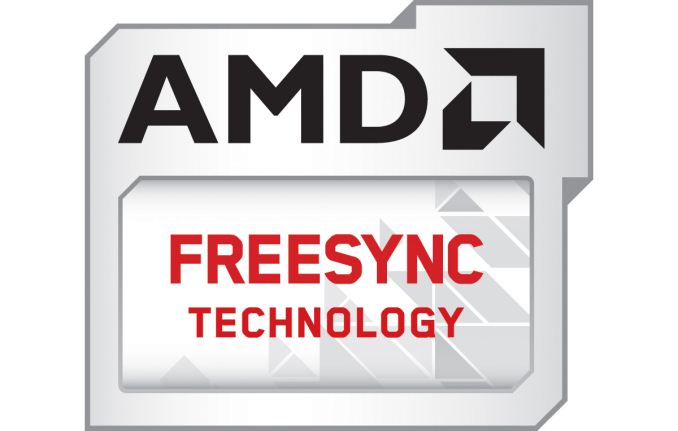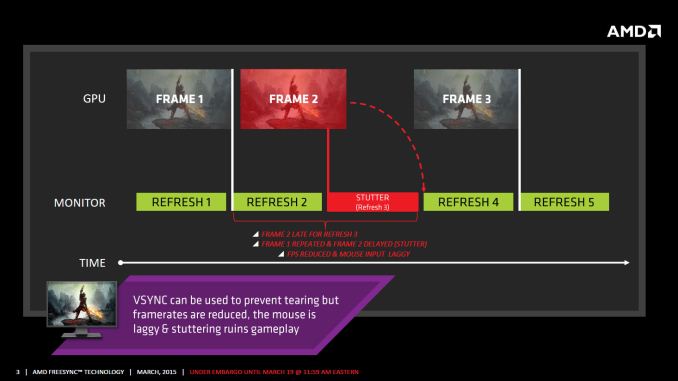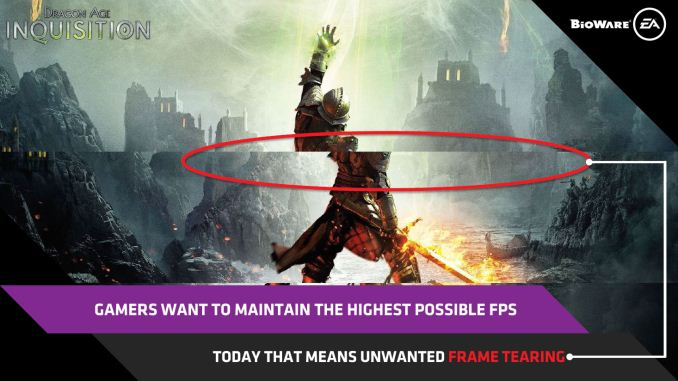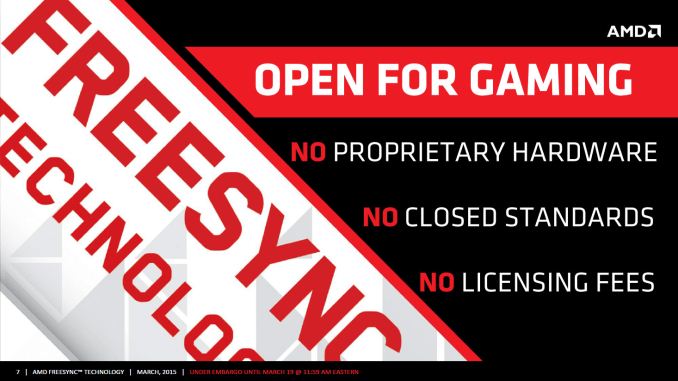The AMD FreeSync Review
by Jarred Walton on March 19, 2015 12:00 PM EST
Introduction to FreeSync and Adaptive Sync
The first time anyone talked about adaptive refresh rates for monitors – specifically applying the technique to gaming – was when NVIDIA demoed G-SYNC back in October 2013. The idea seemed so logical that I had to wonder why no one had tried to do it before. Certainly there are hurdles to overcome, e.g. what to do when the frame rate is too low, or too high; getting a panel that can handle adaptive refresh rates; supporting the feature in the graphics drivers. Still, it was an idea that made a lot of sense.
The impetus behind adaptive refresh is to overcome visual artifacts and stutter cause by the normal way of updating the screen. Briefly, the display is updated with new content from the graphics card at set intervals, typically 60 times per second. While that’s fine for normal applications, when it comes to games there are often cases where a new frame isn’t ready in time, causing a stall or stutter in rendering. Alternatively, the screen can be updated as soon as a new frame is ready, but that often results in tearing – where one part of the screen has the previous frame on top and the bottom part has the next frame (or frames in some cases).
Neither input lag/stutter nor image tearing are desirable, so NVIDIA set about creating a solution: G-SYNC. Perhaps the most difficult aspect for NVIDIA wasn’t creating the core technology but rather getting display partners to create and sell what would ultimately be a niche product – G-SYNC requires an NVIDIA GPU, so that rules out a large chunk of the market. Not surprisingly, the result was that G-SYNC took a bit of time to reach the market as a mature solution, with the first displays that supported the feature requiring modification by the end user.
Over the past year we’ve seen more G-SYNC displays ship that no longer require user modification, which is great, but pricing of the displays so far has been quite high. At present the least expensive G-SYNC displays are 1080p144 models that start at $450; similar displays without G-SYNC cost about $200 less. Higher spec displays like the 1440p144 ASUS ROG Swift cost $759 compared to other WQHD displays (albeit not 120/144Hz capable) that start at less than $400. And finally, 4Kp60 displays without G-SYNC cost $400-$500 whereas the 4Kp60 Acer XB280HK will set you back $750.
When AMD demonstrated their alternative adaptive refresh rate technology and cleverly called it FreeSync, it was a clear jab at the added cost of G-SYNC displays. As with G-SYNC, it has taken some time from the initial announcement to actual shipping hardware, but AMD has worked with the VESA group to implement FreeSync as an open standard that’s now part of DisplayPort 1.2a, and they aren’t getting any royalties from the technology. That’s the “Free” part of FreeSync, and while it doesn’t necessarily guarantee that FreeSync enabled displays will cost the same as non-FreeSync displays, the initial pricing looks quite promising.
There may be some additional costs associated with making a FreeSync display, though mostly these costs come in the way of using higher quality components. The major scaler companies – Realtek, Novatek, and MStar – have all built FreeSync (DisplayPort Adaptive Sync) into their latest products, and since most displays require a scaler anyway there’s no significant price increase. But if you compare a FreeSync 1440p144 display to a “normal” 1440p60 display of similar quality, the support for higher refresh rates inherently increases the price. So let’s look at what’s officially announced right now before we continue.













350 Comments
View All Comments
Crunchy005 - Saturday, March 21, 2015 - link
Sorry, tried to play nice higher up...chizow - Saturday, March 21, 2015 - link
Again, there is nothing religious about technology, it seems you are the ones who are clinging to faith despite photographic evidence to the contrary.silverblue - Saturday, March 21, 2015 - link
Worse, my dear chizow, worse. 'Worst' doesn't go with 'a', but it does go with 'the' as it denotes an extreme.HTH. :)
silverblue - Saturday, March 21, 2015 - link
I think what would clear up your misgivings with FreeSync would be if a very high quality panel with a very wide frequency range (especially dealing with those lower frequencies) was tested. I shouldn't blame the underlying technology for too much yet, especially considering there are downsides to GSync as well.chizow - Saturday, March 21, 2015 - link
There have been numerous reports that the BenQ panel shares the same high quality AU optronics panel as the ROG Swift, so again, it is obvious the problem is in the spec/implementation, rather than the panel itself. But yes, it is good confirmation that the premium associated with G-Sync is in fact, worth it if the BenQ shows these problems at $630 while the Swift does not at $780.silverblue - Sunday, March 22, 2015 - link
FreeSync works down to 9Hz; it'd be nice to see a panel that gets even remotely close to this.chizow - Monday, March 23, 2015 - link
AMD claims the spec goes as low as 9Hz, but as we have seen it has a hard enough working properly at the current minimums of 40 and 48Hz without exhibiting serious issues, so until those problems directly tied to low refresh and pixel decay are resolved, it doesn't really matter what AMD claims on a slidedeck.soccerballtux - Friday, March 20, 2015 - link
I disagree, the holy grail to get me to upgrade is going to be a 32" 1440p monitor (since 30" 1600p ones are non-existent), and maybe one that's just 60fps.JarredWalton - Friday, March 20, 2015 - link
I'd really love a good 34" 3440x1440 display with a 120Hz refresh rate. Too bad that's more bandwidth than DP provides. And too bad gaming at 3440x1440 generally requires more than any single GPU other than the GTX Titan X. I've got CrossFire 290X and SLI 970 incidentally; when I'm not testing anything, it's the GTX 970 GPUs that end up in my system for daily use.Impulses - Friday, March 20, 2015 - link
I'd totally go for a 34" 3440x1440... Wouldn't be any harder to drive than my 3x 24" 1080p IPS displays in Eyefinity. I've resigned myself to CF/SLI, it's not like I play very many games at launch anyway. Anything lower res, smaller, or not as wide would feel like a side grade.